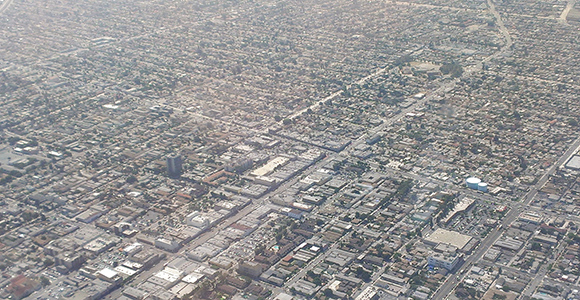
South Los Angeles, California (Photo: Alfred Twu/Wikimedia)
More than three million Californians live in some 879 federally designated Opportunity Zones in disadvantaged communities throughout the state. California has more Opportunity Zones than any other state.
The federal Opportunity Zone incentive allows investors to defer federal taxation on capital gains by investing the proceeds through a qualified opportunity fund into a designated Opportunity Zone. To be eligible for the full benefit, investments must be long-term (at least 10 years) and meet a set of rules designed to ensure these investments create additional economic activity in Opportunity Zone communities.
To maximize the potential impact for Opportunity Zone residents, the state needs to pass legislation that will help communities become “Opportunity Zone Ready.”
“No such action has been taken yet in California,” CA Fwd CEO Jim Mayer wrote recently. “This is a serious missed opportunity to tap an unprecedented source of private capital in communities that need it most, and the state is running out of time to act.”
Governor Newsom has shown support for Opportunity Zones and ensuring California is a competitive environment for impact investments that can support community-building projects and local businesses. As the governor said at the Opportunity Zone Investor Summit at Stanford University last month, for the program to succeed it must spark investment while benefiting existing residents, rather than just investors. “We don’t just believe in growth,” Gov. Newsom said at Stanford. “We believe in inclusion. You can’t have one without the other.”
“Opportunity Zones provide an excellent opportunity to revitalize low-income areas in California,” said Lenny Mendonca, chief economic and business advisor to Governor Newsom. “In order to move the economic needle for millions of Californians who are struggling, attracting investment in areas where they live is sound policy that can help us meet our objective of making California's economy more sustainable and inclusive.”
One example of a community that could benefit is the city of Lynwood, where roughly 70,000 people live in the working-class area of south east Los Angeles County.
“Economic development is a strategic priority for our city and many more like us,” said Jose Ometeotl, Lynwood city manager. “This investment vehicle can help us attract capital, improve our tax base and create jobs for our residents. I expect Governor Newsom and the Legislature will make sure California conforms to the federal requirements so communities like ours can compete for investment. “
CA Fwd and Golden State Opportunity will release a new study next week showing that between $745 million and $1.2 billion in new economic activity in Opportunity Zones could be generated this year. In subsequent years, increased economic activity would range from more than $700 million to nearly $500 million.
“This study reaffirms what we already believed. Opportunity Zones will generate a significant return on investment and a much-needed boost to underinvested communities at a relatively minor overall expense to the state,” said Josh Fryday, president of Golden State Opportunity. “Opportunity Zones can be an important community-driven investment tool that complements other investments by the state and philanthropy in people, places and much-needed projects.”
These incentives would mean a potential revenue loss to the state of $65 million annually between 2019 and 2025, while local tax revenue is expected to cumulatively increase by $68 million over that same time period. Critics have said this incentive is an unnecessary expense, but according to the study, state support for Opportunity Zones will generate at least 10 times the economic impact in these areas, and state tax revenue would be largely recovered when deferred capital gains taxes are paid following the 2026 year.
“We are encouraged by the excitement in the investor community and encourage everybody to think about these investments as not simply about a tax benefit but about measurable long-term economic impact on the communities they are meant to serve,” Mendonca added.
The California Economic Summit in 2018 developed a framework that emphasized three steps that must be taken to maximize the social benefits of Opportunity Zones:
- Make state resources available to communities that want to be “Opportunity Zone-ready”
- Align state community, economic and workforce development funds to leverage social and environmental benefits of Opportunity Zones
- Conform state capital gains tax treatment to the new federal law
Governor Newsom and legislative leaders will be sent the report on Monday and a series of meetings explaining the potential benefits are being scheduled.
“California is one of few states that have not yet enacted legislation conforming to the federal program,” said Mayer. “We believe that as legislators learn more about the program, they’ll make sure California isn’t left behind.”

